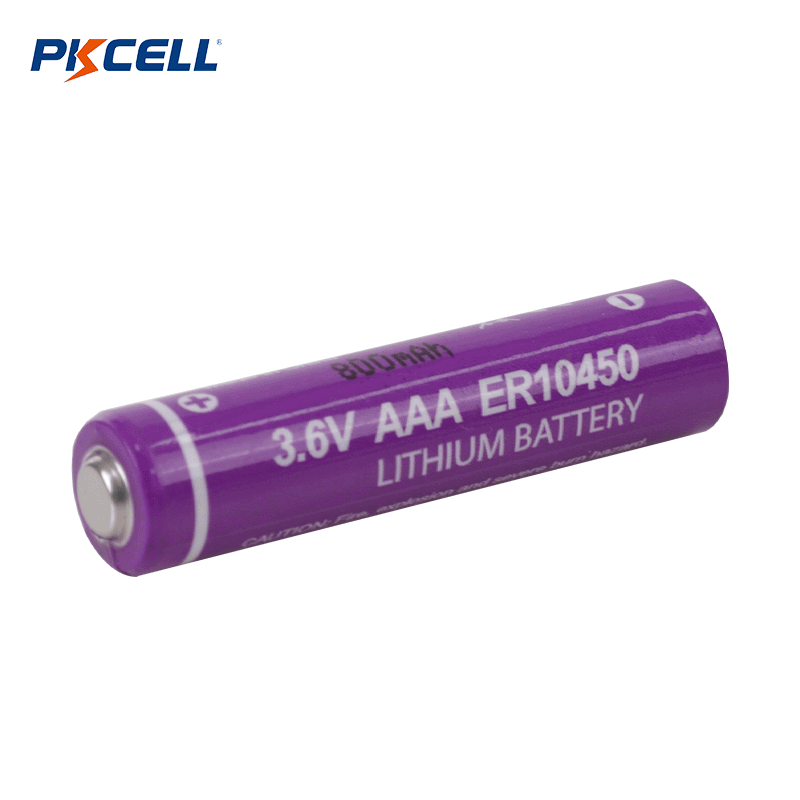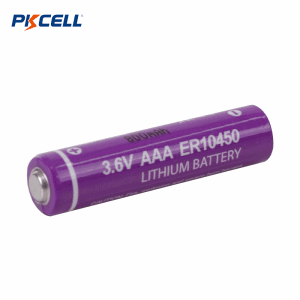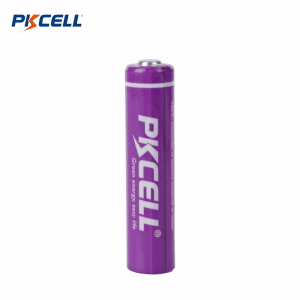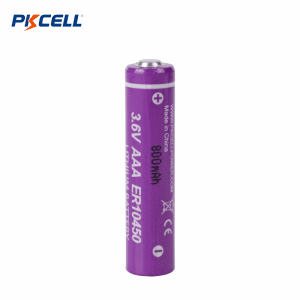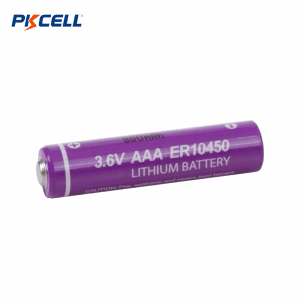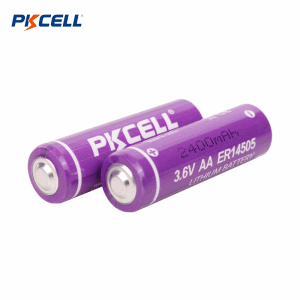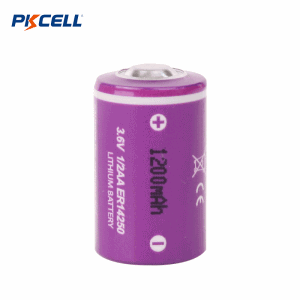3.6V AAA ER10450 Li-SoCl2 Battery (800mAh)
Short Description:
PKCELL LiSoCl2 Series batteries deliver extremely high voltage (3.6 V) and high energy density (620 Wh/Kg) to support product miniaturization. These extended life cells feature low annual self-discharge along with the ability to generate moderate pulses by harnessing the passivation effect. These ruggedized cells feature the widest temperature range (-60°C to 85°C) to perform reliably under extreme environmental conditions, along with a hermetically sealed can to deliver superior leak prevention vs. crimped seals.
Typical Applications:
Alarms and security systems, GPS, metering systems, memory back up, tracking system and GSM communication, Aerospace, Defence, Military, Power Management, Portable Devices, Consumer Electronics, Real-time clock, Tracking system, Utility metering,etc.
Features:
1) High Energy density, High voltage, stable during most of the application’s lifetime
2) Wide range of operating temperature
3) Long self-discharge rate (≤1% per year during Storage)
4) Long storage life (10 years under room temperature)
5) Hermetic glass-to-metal sealing
6) Non-flammable electrolyte
7) Meet IEC86-4 safety standard
8) Safe to export MSDS, UN38.3 cert. available
Storage condition:
clean, cool (preferably below +20℃, not exceeding +30℃), dry and ventilated.
Warning:
1)These are non rechargeable batteries.
2)Fire, explosion and burn hazard.
3)Do not recharge, short circuit,crush, disassemble, heat above 100℃ incinerate.
4)Do not use the battery beyond the permitted temperate range.
| Li-SOCl2(Energy Type) | ||||||||||
| Model IEC | Nominal Voltage(V) | Dimensions (mm) | Nominal Capacity (mAh) | Standard Current (mA) | Max Continuous Discharge Current (mA) | Max Pulse Discharge Current (mA) | Cut-off Voltage (V) | Weight Approx (g) | Operating Temperature (°C) | |
| ER10450 | AAA | 3.6 | 10.0×45.0 | 800 | 1.00 | 10 | 20 | 2.00 | 9 | -55~+85 |
| ER14250 | 1/2AA | 3.6 | 14.5×25.0 | 1200 | 0.50 | 50 | 100 | 2.00 | 10 | -55~+85 |
| ER14335 | 2/3AA | 3.6 | 14.5×33.5 | 1650 | 0.70 | 50 | 100 | 2.00 | 13 | -55~+85 |
| ER14505 | AA | 3.6 | 14.5×50.5 | 2400 | 1.00 | 100 | 200 | 2.00 | 19 | -55~+85 |
| ER17335 | 3.6 | 17×33.5 | 2100 | 1.00 | 50 | 200 | 2.00 | 30 | -55~+85 | |
| ER17505 | 3.6 | 17×50.5 | 3400 | 1.00 | 100 | 200 | 2.00 | 32 | -55~+85 | |
| ER18505 | A | 3.6 | 18.5×50.5 | 4000 | 1.00 | 100 | 200 | 2.00 | 32 | -55~+85 |
| ER26500 | C | 3.6 | 26.2×50.5 | 8500 | 2.00 | 200 | 400 | 2.00 | 55 | -55~+85 |
| ER34615 | D | 3.6 | 34.2×61.5 | 19000 | 3.00 | 200 | 400 | 2.00 | 107 | -55~+85 |
| ER9V | 9V | 10.8 | 48.8×17.8×7.5 | 1200 | 1.00 | 50 | 100 | 2.00 | 16 | -55~+85 |
| ER261020 | 3.6 | 26.5×105 | 16000 | 3.00 | 200 | 400 | 2.00 | 100 | -55~+85 | |
| ER341245 | 3.6 | 34×124.5 | 35000 | 5.00 | 400 | 500 | 2.00 | 195 | -55~+85 | |
Frequently Asked About LiSoCl2 Battery Passivation
Passivation is a surface reaction that occurs spontaneously on the lithium metal surface in all primary Lithium batteries with liquid cathode material such as Li-SO2, Li-SOCl2 and Li-SO2Cl2. A film of lithium chloride (LiCl) quickly forms on the lithium metal anode surface, and this solid protecting film is called the passivation layer, that prevents direct contact between the anode (Li) and the cathode (SO2, SOCl2 and SO2Cl2). Put simply, it prevents the battery to be in permanent internal short circuit and discharging of its own accord. That’s why it enables liquid cathode-based cells to have a long shelf life.
The longer the time and the higher the temperature, the more serious the passivation of lithium thionyl chloride batteries.
The passivation phenomenon is an inherent characteristic of lithium thionyl chloride batteries. Without passivation, lithium thionyl chloride batteries cannot be stored and lose their use value. Since the lithium chloride generated on the surface of metallic lithium in thionyl chloride is very dense, it prevents further reaction between lithium and thionyl chloride, making the self-discharge reaction inside the battery very small, which is reflected in the characteristics of the battery, that is, the storage life is more than 10 years. This is the good side of the passivation phenomenon. Therefore, the passivation phenomenon is to protect the battery capacity and will not cause the loss of battery capacity.
The adverse effects of the passivation phenomenon on electrical appliances are: After a period of storage, when it is first used, the initial operating voltage of the battery is low, and it takes a certain amount of time to reach the required value, and then to the normal value. This is what people often call "voltage lag". Voltage lag has little effect on uses that do not have strict time requirements, such as lighting; but for uses that have strict time requirements, if used improperly, it can be said to be a fatal flaw, such as weapon systems; it has little effect on uses where the current does not change much during use, such as memory support circuits; but for use conditions where the current occasionally changes, if used improperly, it can also be said to be a fatal flaw, such as the current smart gas meters and water meters.
1. Trying to reduce your consumption at all costs
2. Not taking into account the field temperature of your application
3.Overlooking the application's minimal cut-off voltage
4. Choosing a battery that is bigger than necessary
5. Not considering the specific pulse requirements in the discharge profile of your application
6. Taking the information indicated on the datasheet at face value
7. Believing that a test at ambient temperature is fully representative of the overall field behavior of your application


